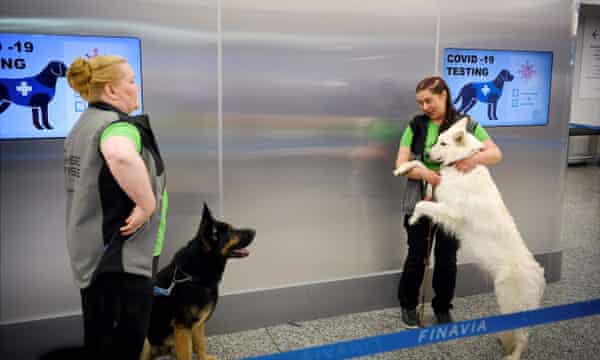What does a pandemic smell like?
If dogs could talk, they might be able to tell us. As the COVID-19 pandemic continues to spread, early, ideally real-time, identification of SARS-CoV-2 infected individuals is pivotal in interrupting infection chains.
Teams of scientists and researchers around the world are training sniffer dogs to detect COVID-19 in humans. And the results show they are friends to both humans and science. The method is certainly more friendly than the intrusive PCR test and the antibody test, and it is also starting to prove effective.
Around the world, canines(dogs) are being trained to detect the whiff of COVID-19 infections. Dog trainers are claiming extraordinary results — in some cases, they say that dogs can detect the virus with almost perfect accuracy. Scientists involved with the efforts suggest that canines could help to control the pandemic because they can screen hundreds of people an hour in busy places such as airports or sports stadiums, and are cheaper to run than conventional testing methods such as the RNA-amplification technique PCR. These detector dogs are trained using sweat samples from people infected with COVID-19. When introduced to a line of sweat samples, most dogs can detect a positive one from a line of negative ones with 100% accuracy.
The Canine coronavirus test:
In Finland’s Helsinki-Vantaa airport is already deploying dogs, including Kössi, a rescue dog from Spain, for their new job in a pilot project running alongside more usual testing at the airport.
In the canine coronavirus test, a passenger swipes their neck with a gauze, places it in a can which is then handed over to another room for Kössi or its colleagues ET, Miina and Valo, to sniff and to deliver an immediate result in minutes by scratching a paw, laying down, barking or otherwise making its conclusion known. Passengers who volunteer for the test are told to also take a free PCR test to confirm the result.
Across the globe, coronavirus detector dogs are being trained in the United Arab Emirates (UAE), Chile, Argentina, Brazil and Belgium. In the UAE, detector dogs – stationed at various airports – have already started helping efforts to control COVID-19’s spread.
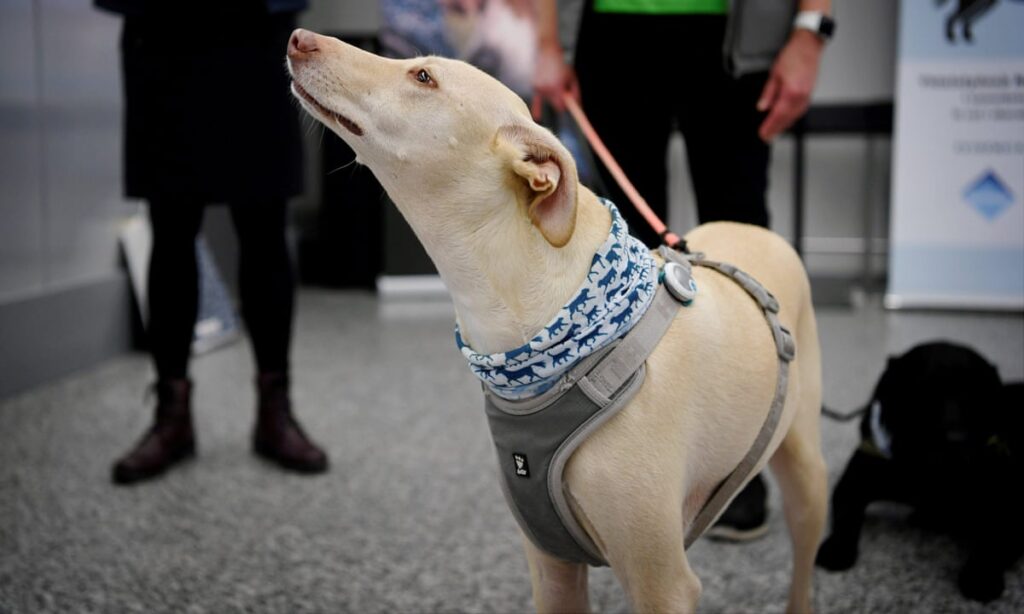
Kössi is one of the dogs working to detect COVID-19 in passengers at Finland’s Helsinki airport. /Antti Aimo-Koivisto/Lehtikuva/AFP
How accurate is this?
Saliva samples and tracheobronchial secretion samples were collected from hospitalised COVID-19 patients that showed clinical symptoms and were diagnosed as SARS-CoV-2 positive using nasopharyngeal swab samples. Negative control samples were obtained from SARS-CoV-2 RT-PCR negative people with no previous history of COVID-19, nor had the individuals any history of a recent cold or infection.
The researchers trained eight dogs on samples taken from the mouths and windpipes of seven people hospitalized with COVID-19 and seven uninfected people. The dogs identified 83% of positive cases and 96% of negative ones.
Sense of wonder
Humans have taken advantage of canines’ superior sense of smell for decades. Dogs’ noses bear 300 million scent receptors, compared with humans’ 5 million or 6 million. Perhaps a dog’s sense of smell is around thousands of times more powerful than a human’s. It’s not just their noses that make them effective at the job, it’s also the area of their brain that’s responsible for processing smell, which is around 40 times larger than the size of a human’s. All these amazing features in dogs make them more aware of smells in a way that humans cannot understand. That enables them to detect tiny concentrations of odour that people can’t.
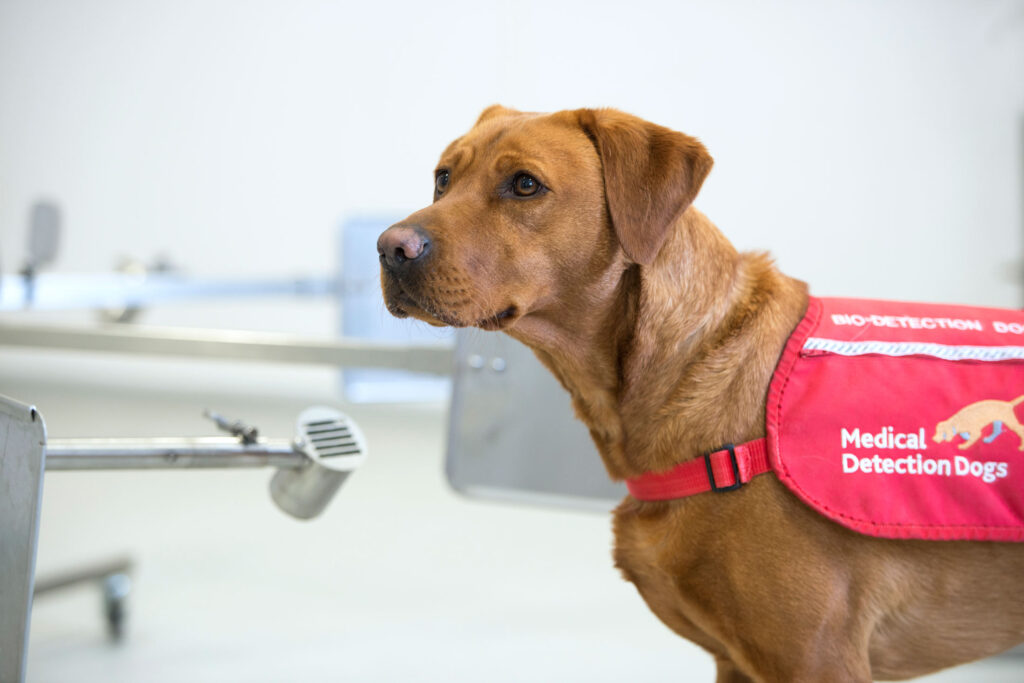
Sniffer dogs are already a familiar sight in airports, where they detect firearms, explosives and drugs. Scientists have also trained dogs to detect some cancers and malaria, but the animals are not routinely used for this purpose. Researchers don’t know for sure what the dogs are smelling, but many suspects that these illnesses cause the human body to let off a distinct pattern of volatile organic compounds (VOCs). These molecules readily evaporate to create scent that dogs can pick up.
According to researchers, training the dogs takes only a few weeks, and with the speed at which the dogs are able to identify the virus on carriers, this method could prove very efficient and reliable, with the possibility of wide deployment at airports, ports of entry or transport hubs.
Can all dogs do it?
According to Gudi Stuttard, while theoretically all breeds of dogs should have this better sense of smell than humans, in practice, certain breeds and individuals of dogs are better candidates for scent detection work. Longer-nose breeds tend to be more reliable.
But with a longer nose comes greater responsibility, as the dogs must also show that they have the skills needed for the position.
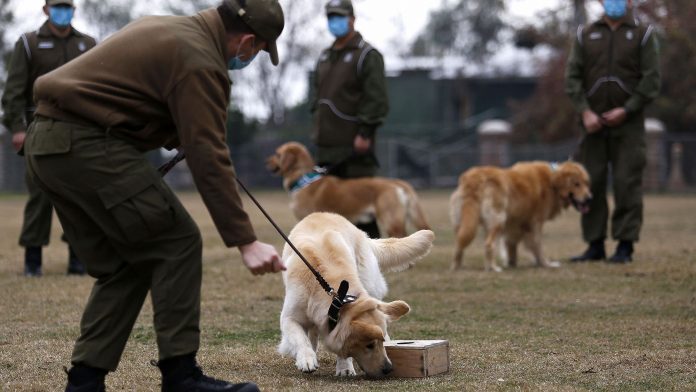
Also, Certain breeds and individuals are much more trainable. And that’s really important, it’s not just about the dog’s ability to detect smell, also the effort to train these dogs and they have to be happy to work with their sense of smell. The breeds commonly seen as fit for scent detection work, include German Shepherds, Labradors, poodles, and spaniels, partly because they have that better sense of smell, but they’re also dogs that are really trainable and really happy to work with humans.
Could the dogs spread the virus further?
Dogs in experimental studies have not been shown to be able to replicate the virus (within their body). Simply, they themselves are not a source of infection. Currently, there are two case reports in the world of dogs being potentially contaminated with the COVID-19 virus by their owners. Those dogs didn’t become sick. To further reduce any potential risk of transmission to both people and dogs.
The apparatus used to train the dogs doesn’t allow any direct contact between the dog’s nose and the sweat sample. The dog’s nose goes into a stainless steel cone, with the sweat sample in a receptacle behind. This allows free access to the volatile olfactory compounds but no physical contact.
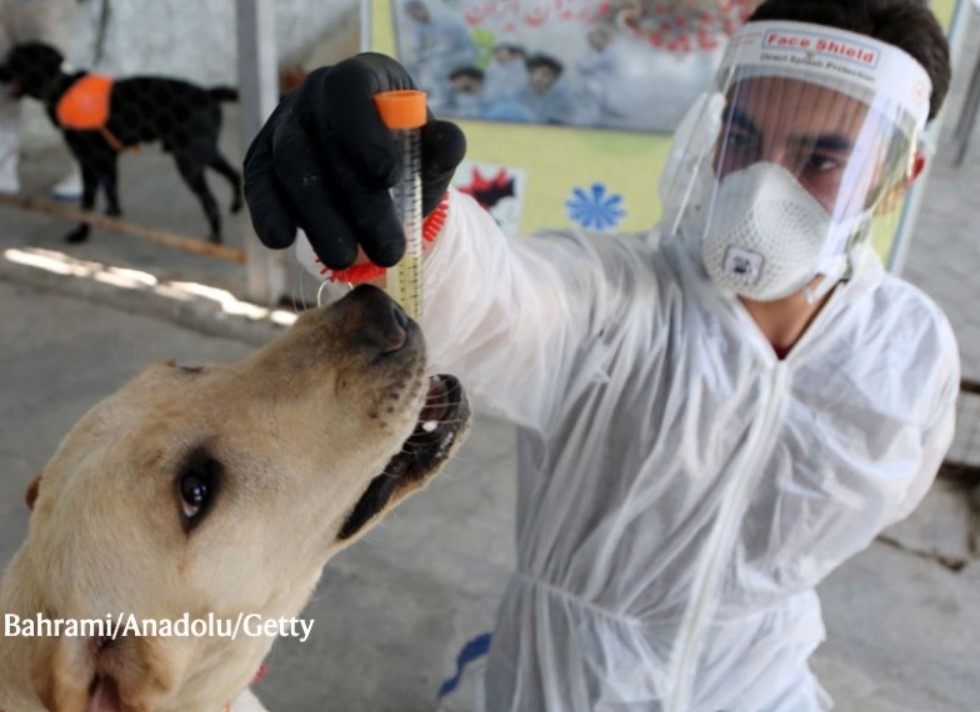
Furthermore, all the dogs trained to detect COVID-19 are regularly checked by nasal swab tests, rectal swab tests and blood tests to identify antibodies. So far, none of the detector dogs has been found to be infected.
Read also: Animals that inspired Technological innovations
A friend to us (and science)
Perhaps we shouldn’t be surprised about dogs’ ability to detect COVID-19, as we already know their noses are amazing.
Dogs can help detect hypoglycaemia in diabetics, warn people who are about to have an epileptic seizure and have been used to sniff out some cancers. Their great potential in dealing with the current pandemic is just one of myriad examples of how dogs enrich our lives.
References:1. Jendrny, P. et al.BMC Infect. Dis.20, 536 (2020).https://bmcinfectdis.biomedcentral.com/articles/10.1186/s12879-020-05281-32.https://theconversation.com/3.https://www.cgtn.com/4.https://www.nature.com/
